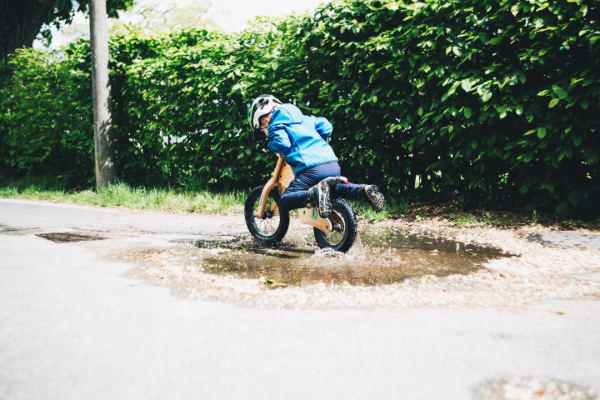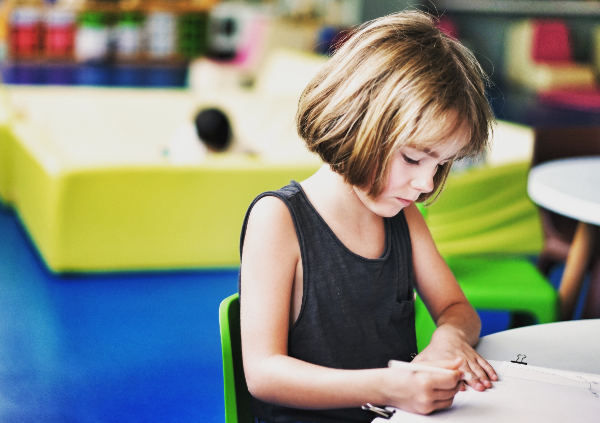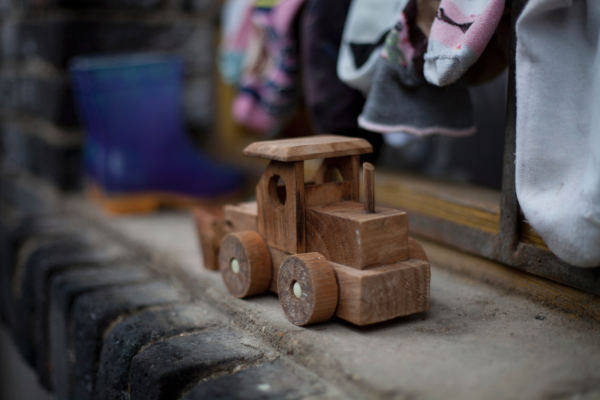How children grow, an occupational therapy food for thought
"Should we send our boy for additional behavioral therapy?" - This is a question that has been on my mind for a long time, so my thoughts on this question are now in writing.
I don't want to answer this question. I want to get off topic and then ask you the same thing at the end. I'm already curious about your answer, so feel free to leave it in a comment.
When I explain my thinking about this in a moment, I am referring to boys first and foremost in my mind. Not because girls are not affected by this issue, but because in my work practice I feel it affects them much less often. This may be because, at least if you follow what Gerald Hüther says, boys are the constitutionally weaker sex. But who knows. I can only judge from past experience.
When a child grows up, by grow up I mean in the womb, it already makes experiences. It already has a brain, so it also uses that. However, it does not think anything, but actually only what it can perceive in its situation. These are different things, there are the common things that all parents probably already know, like the heartbeat of mummy, the music box that is held to the belly by caring parents every evening so that the child kicks in order to become a footballer later...
No, seriously now, children probably already learn more during this time than we gave them credit for. They feel secure and safe and therefore learning probably works all the better. But the children also want to grow during this time, which is not particularly difficult for them, since they are provided for all-inclusively via the placenta. We notice that children want to grow, for example, by the fact that they move, that they do this soccer training and gather experiences (neuronal networks) concerning their own body, but also concerning the environment, and develop further on the basis of these experiences. So that the unaimed kick turns into a finer movement, which allows the infant to guide its little thumb into its own mouth and to realize through the satisfying sucking on this very thumb that there is much more experience to be made.
So let's keep in mind: already unborn children (want to) grow and they feel cared for and secure.
When this child has survived its first battle against the environment, i.e. birth, then everything has changed for this little creature that it knew before and felt safe. That this is not a nice situation, you can imagine. But fortunately, Mama's warm body, her heartbeat and also sucking on her breast can bring back part of this prenatal feeling. The child experiences that it is safe and cared for even in this cold, bright and dry world. Just as it perceives the environment more clearly due to the lack of amniotic fluid and first needs a few weeks to adjust to this setting. Thus it decides again that it wants to grow and live.
Grow and live. This is what this child then does and learns to walk, it explores the environment, the reactions of the environment and of course itself, its own body, its own abilities. And if it is lucky, it makes the experience that the environment is worth exploring, that the reactions offer it a safe living space, that its own body fits perfectly into this living space and that its own abilities are sufficient to shape this living space. The perfect ingredients for an adult who can take care of himself and produce offspring, as well as give them a sense of security.

Sounds simple. It is. But there is a catch to the story. The growth that Mr. Occupational Therapist has described is solely from the child, in the story the environment is quite passive and there is no one who wants to "make something" out of this child, to "educate" it. Why I described it this way is because I don't think much of education, since it only sows the seeds of one's own harvest, i.e. parental experiences. This, in turn, means that it prepares children for what they have already experienced. Sounds good if you believe that the world will remain as it is. So to that you can say that lately we have smartphones and stuff like that... That didn't exist before.
Where was I? Yes, exactly, the child now meets someone who makes demands. Someone who expects a performance or behavior. Someone who already knows exactly how this should look. This child does not know that yet. When it meets this person probably varies socially, probably at the latest in school.

Then, all of a sudden, the child has to be able to do things that it has not yet explored, that perhaps were not yet worth exploring. Things that have perhaps not yet appeared in one's own living space. In occupational therapy, it is often fine motor skills such as pen holding.

The child probably does not even understand what is wrong with the way he holds his pencil. After all, they haven't often seen mom or dad hold a pen. They write everything on the keyboard now. Well, but in life it's important to be able to hold the pen well, so they practice until they get it right.
Later, the child realizes that there are topics that he or she doesn't even find that interesting. It develops its own interests. Then, however, it realizes that it does not fit to have own interests, because an uninteresting school subject has a negative effect on the performance. The educator states that this must be related to the fact that the child is always distracted in class. Accordingly, a discussion with the parents is necessary. They should try to take measures so that the child can make it through school.
It is looked how one can help the child. How to adjust his behavior so that it works better in school. It is not the teaching that is adjusted to the child - it is the child that does not fit, so he should do concentration training. It must learn to devote itself for some time to a thing, which does not make it fun and to distract thereby none of the classmates. The child probably does not even understand why it is necessary to learn things that are not fun. So far, it has made the experience that it always learned especially much about a thing when it was fun for it. - By the way, from a learning theory point of view, this is the most sustainable way to learn something new, if it is linked to emotions, such as joy, at the same time. Or can anyone of you still divide in writing, which for many of us is surely rather linked to negative emotions, if at all ;-).
Another child from our child's class has completely different worries. He can hardly sit still at school. His parents separated when he was very small. He lives with his mom and she tries hard to make it work. But the child still notices that it is difficult for her and that the situation also overwhelms her.
It has already made the experience very early on that the first people it was allowed to get to know in this world after its birth and who gave it this feeling of security are now separated. That one of these people now offers him less security. Due to the excessive demands of his single mother, the child finds himself in a situation where his support is crumbling. The support that gave the child the necessary security so that it could grow. It probably can't put it into words yet, but inside this feeling of being abandoned again is there. It is tense, this becomes clear at school, for example, through motor restlessness. It tilts, it unconsciously tries to keep moving because it cannot stand the rest.
In therapy, I sometimes encounter children who tremble violently with their arms during relaxation exercises, who on the one hand try to engage with the situation, but on the other hand cannot let go inwardly.
The educators' advice often seems to be to ask the children's parents to talk to them and tell them that their child needs closer support at school. That the parents should contact a doctor and have the child evaluated for "disorders."
Of course, the fact that the child now has a disorder does not solve the problem in the least. However, it does make a lot of things easier. A child with a "disorder" is more easily approved for special care requests. Then he has someone at his side who focuses him on his tasks. Who permanently shows him his behavior.
A "disturbed" child is prescribed certain medications, which do not correct the "disorder", but prevent the occurrence of the undesirable behavior. Making the children quiet. To make them concentrate better.
And the child? For the child, there is now clarity in any case. It's not so perfect for its environment after all. It doesn't seem to fit in so well in this world. It has a disorder, and so it is probably something like a flower that does not bloom. That doesn't bear fruit. Something inferior. That's what it feels like.
Back to therapy. The kids are in the waiting room and already full of anticipation, because ergo, it's fun, here we build things freely from our imagination. Here we learn things we've always wanted to do, but are too dangerous. We cut with a sharp knife, we saw, we burn patterns into the wood with the soldering iron or melt solder to connect the wires of our vehicle with the engine.

The tasks we enjoy are the ones that require us to go above and beyond, where we are excited to learn new things.
Of course, the children do not want to injure themselves during these tasks, which are quite demanding on the children's abilities. Every child knows pain from falling down, at least since they learned to walk. But then, as now, these kids get up and do their best to do better! That doesn't mean they want to be left alone to do it. In the past, it helped if mom or dad offered a hand to hold on to when the terrain was uneven so the walker wouldn't fall. Now, too, children want to feel safe first and foremost when faced with big challenges. Then the task they are facing shrinks to a size that can be overcome. Then the child feels up to the situation.
If children have these experiences more often, they also feel up to life, then they do not face an insurmountable obstacle when faced with disappointments and strokes of fate.
At the end of the therapy, in the best case, the child does not find itself so unsuitable for the environment. In the best case, he or she has experienced that he or she can achieve something on his or her own. That sometimes things have to be worked out with effort and that they can then be achieved. It has also learned that some goals lie on paths that are inconvenient for me. That when you're making a motorized wooden car according to your own ideas, you have to saw and file for a damn long time until everything fits.
Then, strangely enough, it often works better at school. Why do you think that is?
Why did I bring childhood, parents and school into play now? The original question was about the benefits of behavior therapy.
Let me paint another metaphor for you. Inspired by a penguin story by Eckart von Hirschhausen. Just because penguins aren't good fliers, the other birds don't send them to behavior therapy against their will.
So I ask you, "Should we send our boy to behavioral therapy in addition?"
Image source:The cover image of the article comes from pixabay.com.
The image in the article of the wooden car comes from unsplash.com.
The image in the article of the classroom comes from unsplash.com.
The image in the article of the child painting comes from unsplash .com.
The image in the article of the child on the wheel comes from unsplash .com.
No comments yet.